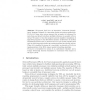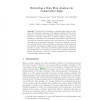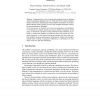ESOP
2004
Springer
14 years 10 months ago
2004
Springer
Abstract. We present PacLang: an imperative, concurrent, linearlytyped language designed for expressing packet processing applications. PacLang’s linear type system ensures that ...
ESOP
2004
Springer
14 years 10 months ago
2004
Springer
Abstract. We show how to formalise a constraint-based data flow analysis in the specification language of the Coq proof assistant. This involves defining a dependent type of lat...
ESOP
2004
Springer
14 years 10 months ago
2004
Springer
EMSOFT
2004
Springer
14 years 10 months ago
2004
Springer
We present a type system for E code, which is an assembly language that manages the release, interaction, and termination of real-time tasks. E code specifies a deadline for each...
ECOOPW
2004
Springer
14 years 10 months ago
2004
Springer
This report summarizes the Fifth Workshop on Programming Languages and Operating Systems (PLOS 2009), which was held in conjunction with the SOSP 2009 conference. This report pres...
ECOOP
2004
Springer
14 years 10 months ago
2004
Springer
Transactional monitors are proposed as an alternative to monitors based on mutualexclusion synchronization for object-oriented programming languages. Transactional monitors have e...
ECOOP
2004
Springer
14 years 10 months ago
2004
Springer
Programmers have come to expect better integration between databases and the programming languages they use. While this trend continues unabated, database concurrency scheduling ha...
ECOOP
2004
Springer
14 years 10 months ago
2004
Springer
Mechanisms in AOP (aspect-oriented programming) can be characterized by a JPM (join point model). AOP is effective in unanticipated software evolution because crosscutting concer...
ECOOP
2004
Springer
14 years 10 months ago
2004
Springer
The expression problem (aka the extensibility problem) refers to a fundamental dilemma of programming: Can your application be structured in such a way that both the data model and...
ECOOP
2004
Springer
14 years 10 months ago
2004
Springer



